How to Upload Public Key to Server
Index
Using Public-Key Authentication in Secure Shell Applications
The tip below provides a bones overview of public-key hallmark, explains how to generate and upload keys to the Secure Beat out server, and shows how to configure SecureCRT and SecureFX clients.
Overview of public-primal authentication for Secure Shell
Public-primal hallmark is a proven, well-established method for authenticating computing devices which is more secure than password authentication. Public-key authentication employs a linked pair of estimator-generated keys — one public and one individual — and a procedure that proves the user's identity without exposing the secret central to theft or hijacking.
Earlier using public-key authentication, the public/private key pair files must exist created, with a copy of the public-key file existence uploaded to a specific location on the server. The public and private keys are generated with a key generation utility. While the private and public keys within a central pair are related, a private key cannot be derived by someone who simply possesses the corresponding public key.
Public-cardinal authentication is only successful when the client proves that it possesses the "clandestine" individual fundamental linked to the public-key file that the server is configured to use. Typically the individual-primal file on the client's machine is protected by a "passphrase", so fifty-fifty if the individual-key file is stolen, an attacker must still know the passphrase in social club to use information technology. In dissimilarity with the "password" authentication method where the password is transmitted between the client and the server during the authentication procedure, the private primal contents are not transmitted between the client and the server. Since the individual primal is never transmitted over the connection, the public-key authentication method is considered to exist more secure than the password hallmark method. Each key is unremarkably betwixt 1024 and 2048 bits in length. Starting with SecureCRT and SecureFX seven.iii and newer, keys larger than 2048 are available if needed. The post-obit is an example of a key generated past SecureCRT.
---- BEGIN SSH2 PUBLIC KEY ---- AAAAB3NzaC1kc3MAAACBAKoxPsYlv8Nu+fncH2ouLiqkuUNGIJo8iZaHdpDABAvCvLZn jFPUN+SGPtzP9XtW++2q8khlapMUVJS0OyFWgl0ROZwZDApr2olQK+vNsUC6ZwuUDRPV fYaqFCHrjzNBHqgmZV9qBtngYD19fGcpaq1xvHgKJFtPeQOPaG3Gt64FAAAAFQCJfkGZ e3alvQDU8L1AVebTUFi8OwAAAIBk9ZqNG1XQizw4ValQXREczlIN946Te/1pKUZpau3W iiDAxTFlK8FdE2714pSV3NVkWC4xlQ3x7wa6AUXIhPdLKtiUhTxtctm1epPQS+RZKrRI XjwKL71EO7UY+b8EOAC2jBNIRtYRy0Kxsp/NQ0YYzJPfn7bqhZvWC7uiC+D+ZwAAAIEA mx0ZYo5jENA0IinXGpc6pYH18ywZ8CCI2QtPeSGP4OxxOusNdPskqBTe5wHjsZSiQr1g b7TCmH8Tr50Zx+EJ/XGBU4XoWBJDifP/6Bwryejo3wwjh9d4gchaoZNvIXuHTCYLNPFo RKPx3cBXHJZ27khllsjzta53BxLppfk6TtQ= ---- END SSH2 PUBLIC Central ----
Successful public-primal authentication requires: (ane) generating a key pair, (2) uploading the public key to the Secure Beat server, and (3) configuring the client to use the public-fundamental authentication method. SecureCRT and SecureFX provide utilities to generate keys and automatically identify a copy of the public fundamental on a VShell® server. Public-primal authentication betwixt a VanDyke Software client application and a non-VShell server such as OpenSSH requires generation of a public/private key pair and placing the public-central file on the server in the right location and in a format supported by the Secure Shell server.
Generating VanDyke Software keys, configuring client applications
VanDyke Software applications generate public/private keys using a simple wizard or a command-line utility. In the SecureCRT or SecureFX Tools menu, the Create Public Key… carte particular launches the Key Generation wizard. The Public-Key Assistant toolbar push button (also institute in the Tools carte) may besides exist used to generate keys.
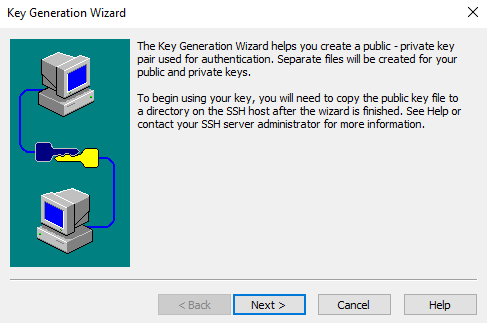
You first choose the type of key (RSA, Ed25519, ECDSA, or DSA) and the passphrase that is used to protect access to your individual fundamental. If using an RSA primal type and SecureCRT or SecureFX 7.three or newer, you tin can so select a key length between 512 and 16,384 bits (SecureCRT and SecureFX versions 7.2 and before are express to key lengths between 512 and 2048 bits). In many organizations, users are given guidelines for these settings. The fourth dimension required to generate a cardinal increases with the key length, and may be several minutes depending on processor speed.

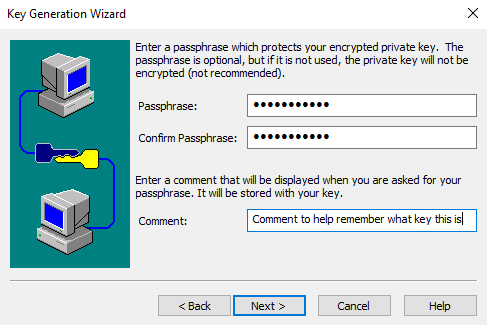
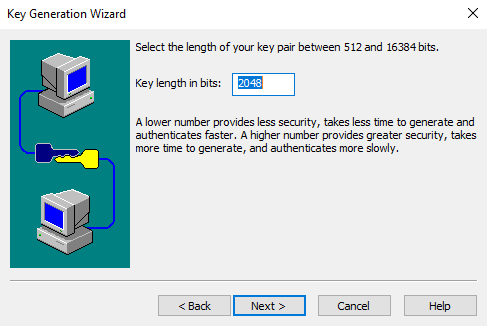
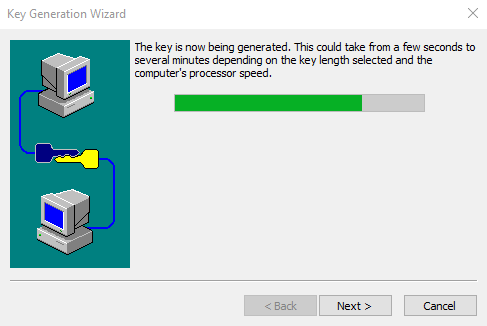
You volition have the choice of storing your fundamental in VanDyke Software format (the public primal is stored in a file that matches the IETF standard format) or in the OpenSSH format. If you are connecting to an OpenSSH server, y'all may want to employ the OpenSSH format to simplify the procedure involved with setting upwardly the remote server with your public-key file. If you lot are connecting to a VShell server, y'all can employ either format since VShell accepts them both.
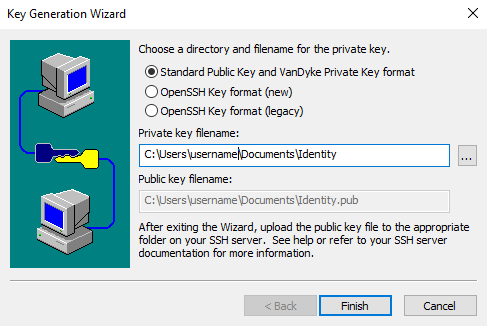
Public- and individual-primal files are placed in a local folder on the machine where the customer application resides, unremarkably with the filename "Identity".
The public key tin be uploaded to a VShell server at the end of the Key Generation wizard process, or at any time later through the Session Options dialog. Utilise the following steps to upload an existing public-fundamental file:
one. In the SSH2 category of Session Options, select the PublicKey option in the Authentication section, and then printing the Properties button.
2. In the Properties dialog, find the Employ identity or certificate file section, and press the file browser push (…).
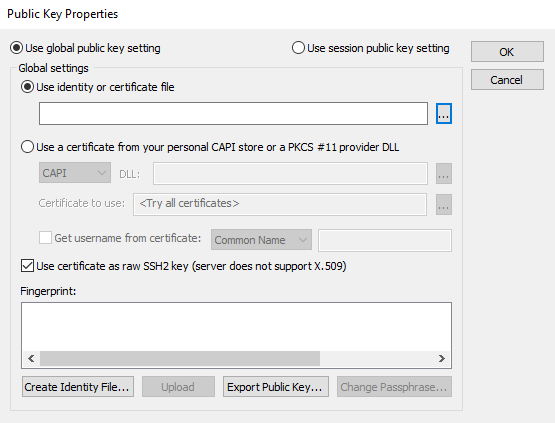
3. Navigate to the key file you want to employ in the Select Identity Filename dialog.
4. Press the Upload button to place the public key on the Secure Shell server.* Note that you lot can as well create keys from this dialog with the Create Identity File... button. This is besides where yous tin change the passphrase for your key.
*Note that the upload instructions apply simply to servers like VanDyke Software's VShell that implement the Secure Shell Public Key Subsystem (RFC 4819). Although at that place may be server implementations that back up the public-key subsystem, those connecting to servers that aren't VShell will typically demand to use transmission methods to place their public-fundamental files on the server to meet the server'southward requirements.
Default fundamental file locations
If y'all demand to configure sessions in the time to come and can't notice your key files, the post-obit table illustrates the default locations used by the public-key wizards on each of the indicated platforms.
| Platform | Fundamental File Location | Case |
|---|---|---|
| Windows | Documents folder | C:\Users\JoeRocket\Documents |
| Mac | .ssh folder in the user's abode directory | /Users/JoeRocket/.ssh |
| Linux | user home directory | /home/JoeRocket |
mcginnisclook1995.blogspot.com
Source: https://www.vandyke.com/support/tips/publickeyauth.html
Post a Comment for "How to Upload Public Key to Server"